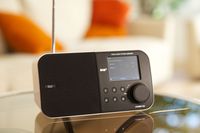Germany - Services on Air - History
15.01.2014
A huge variety of programmes are available: Besides the 13 national programmes, more than 60 public and more than 35 commercial regional programmes are available. Also more than 20 local radio programmes can be received digitally. In total more than 120 radio stations can be received digitally across the 16 German Bundesländer.
The vast majority of radio programmes are equipped with accompanying data services such as Dynamic Label (plus), Slideshows, EPG and TPEG. Journaline and RadioDNS services are broadcast also. ARD broadcasters
are implementing Categorised Slideshow, which will be broadcast as a regular service by September 2013.
National Multiplex
Population: 81,600,000
Total coverage: 78.7%
Ten commercial radio programmes as well as three radio programmes from the national public broadcaster Deutschlandradio are broadcast on the national multiplex, which is operated by Media Broadcast. Pop, rock, electronic and classical music are available as well as spoken word content, debates and Christian radio. This combines an attractive selection of both mainstream and niche content.
The coverage of the national multiplex is extended in 2013 with four new transmitters, allowing digital radio reception of 65% of the German area and alongside 75% of the German Autobahn.
Regional Multiplexes
More than 60 radio programmes from nine ARD-broadcasters are available. The majority of those are ARD’s well-known FM-brands as well as various new digital only stations such as NDR Blue, WDR KiRaKa or BR PULS. All ARD programmes are equipped with an ARD-wide identical (and mandatory) set of data services to accompany the live audio. The network coverage was increased in 2013, allowing reception of the ARD-muxes for fairly 84 % of the German population.
Besides the public broadcasters, various commercial broadcasters launched their programmes in 2012 either together with ARDbroadcasters in mixed multiplexes or in separate commercial only multiplexes operated by Media Broadcast. During 2013 more commercial programmes were added to the existing ensembles.
|
Baden-Württemberg Population: 10.7 million Total coverage: 91.6 % Two networks, one mixed multiplex for public and commercial programmes, the second with public programmes only to fill the white spots. The goal is to increase the network coverage to separate the two multiplexes into a commercial and a public-only multiplex by end of 2014. |
|
Bayern Population: 12.0 million Total coverage: 96.0% Two networks, one for public programmes, the second for commercial programmes. Additional local networks are available in the major Bavarian cities such as Munich, Nürnberg, Ingolstadt and Augsburg. Together with the national multiplex up to 45 radio programmes are available in some regions. |
|
Berlin Population: 3.5 million Total coverage: 100% There are two networks, one for public programmes, the second for both public and commercial programmes, are fully covering Berlin and the surrounding area. |
|
Brandenburg Population: 2.5 million Total coverage: 67.8% Brandenburg is currently just covered by the multiplexes which are being broadcasted in Berlin. The majority of Brandenburgian people are living in the wider area around Berlin. The network expansion in the rural areas of Brandenburg is under consideration. |
|
Bremen Population: 0.7 million Total coverage: 92.3% Radio Bremen launched its digital radio multiplex in February 2013. Alongside the three Radio Bremen programmes (Bremen Eins, Bremen Vier, Nordwestradio) the following programmes are broadcasted: Funkhaus Europa, WDR KiRaKa, Bremen Next. This provides 100% more choice to the Bremen population. |
|
Hamburg Population: 1.8 million Total coverage: 100% There is one multiplex for public programmes, operated by NDR, which fully covers the area around Hamburg since August 2011. |
|
Hessen Population: 6.1 million Total coverage: 91.1% There are two networks, one for public radio programmes, the second for commercial programmes are covering the metropolitan area around Frankfurt and Wiesbaden. The public hr mux also covers the rural areas as well as the important transit routes in northern Hesse. |
|
Mecklenburg-Vorpommern Population: 1.6 million Total coverage: 19.8% There is one multiplex for public programmes, operated by NDR, which covers the metropolitan area around the capital Schwerin. |
|
Niedersachsen Population: 7.9 million Total coverage: 82.4% One multiplex for public programmes, operated by NDR, which covers the main transit routes as well as high-populated and rural areas. |
|
Nordrhein-Westfalen Population: 17.8 million Total coverage: 96.5% One mixed multiplex for public and commercial programmes, operated by WDR, which covers the most populated federal state in Germany, including the so called Ruhr region. |
|
Rheinland-Pfalz Population: 4.0 million Total coverage: 89.0% One mixed multiplex for public and commercial programmes covers the metropolitan area in the Rhein-Main region as well as rural areas and the important transit routes. |
|
Saarland Population: 1.0 million Total coverage: 98.2% One mixed multiplex for public and commercial programmes reaches nearly full coverage of Germany‘s smallest area state. |
|
Sachsen Population: 4.2 million Total coverage: 96.1% There is one mixed multiplex for public and commercial programmes, which has been on air before the DAB+ digital radio launch in 2011. This mixed multiplex covers the majority of Saxony. In addition, public broadcaster MDR has established new networks in the metropolitan areas of Saxony which include ARD’s mandatory minimal set of digital radio services. |
|
Sachsen-Anhalt Population: 2.3 million Total coverage: 93.8% There is one mixed multiplex for public and commercial programmes, which has already been on air before the digital radio launch in 2011, covers the majority of Saxony-Anhalt. In addition, public broadcaster MDR has established new networks in the metropolitan areas of Saxony-Anhalt which include ARD’s mandatory minimal set of digital radio services. |
|
Schleswig-Holstein Population: 2.8 million Total coverage: 75.0 % There is one multiplex for public programmes, operated by NDR, covers the main transit routes as well as the capital Kiel. |
|
Thüringen Population: 2.2 million Total coverage: 80.4% There is one mixed multiplex for public and commercial programmes, which has already been on air before the DAB+ digital radio launch in 2011 and covers the majority of Thuringia. In addition public broadcaster MDR has established new networks in the metropolitan areas of Thuringia which include ARD’s mandatory minimal set of digital radio services. |
Feature of Services on Air

All public ARD radio brands come equipped with many additional services, accompanying  the live audio service. This is due to the heavy media research, undertaken prior to the digital radio launch and – as it is consistent for all of ARD’s brands – offers a mouldbreaking experience for all listeners across Germany. The so called minimal set of services consists of:
the live audio service. This is due to the heavy media research, undertaken prior to the digital radio launch and – as it is consistent for all of ARD’s brands – offers a mouldbreaking experience for all listeners across Germany. The so called minimal set of services consists of:
- Now-next information (DLS/DL+)
- Programme previews (EPG)
- Weather and traffic charts, news headlines, track/title-cover (Slideshow/cat. Slideshow)
- Future mobility service (TPEG)
- Hybrid EPGs and Slideshows (RadioVIS and RadioEPG)
The radio stations on the national multiplex offer a superior programme variety hence more choice for its listeners. Choice is not only limited to mainstream stations but also covers niche content such as electronic, hard-rock and lounge music, talk and debate as well as knowledge and science programmes, Christian and culture radio. Also specific football content is available on the national multiplex every match day of the 1st and 2nd Bundesliga. The right holder for Bundesliga football (Sport1) has an agreement with the radio station NRJ which broadcasts the conference on match days on the national multiplex.



11.09.2013
A huge variety of programmes are available: Besides the 13 national programmes, more than 60 public and more than 35 commercial regional programmes are available. Also more than 20 local radio programmes can be received digitally. In total more than 120 radio stations can be received digitally across the 16 German Bundesländer.
The vast majority of radio programmes are equipped with accompanying data services such as Dynamic Label (plus), Slideshows, EPG and TPEG. Journaline and RadioDNS services are broadcast also. ARD broadcasters
are implementing Categorised Slideshow, which will be broadcast as a regular service by September 2013.
National Multiplex
Population: 81,600,000
Total coverage: 78.7%
Ten commercial radio programmes as well as three radio programmes from the national public broadcaster Deutschlandradio are broadcast on the national multiplex, which is operated by Media Broadcast. Pop, rock, electronic and classical music are available as well as spoken word content, debates and Christian radio. This combines an attractive selection of both mainstream and niche content.
The coverage of the national multiplex is extended in 2013 with four new transmitters, allowing digital radio reception of 65% of the German area and alongside 75% of the German Autobahn.
Regional Multiplexes
More than 60 radio programmes from nine ARD-broadcasters are available. The majority of those are ARD’s well-known FM-brands as well as various new digital only stations such as NDR Blue, WDR KiRaKa or BR PULS. All ARD programmes are equipped with an ARD-wide identical (and mandatory) set of data services to accompany the live audio. The network coverage was increased in 2013, allowing reception of the ARD-muxes for fairly 84 % of the German population.
Besides the public broadcasters, various commercial broadcasters launched their programmes in 2012 either together with ARDbroadcasters in mixed multiplexes or in separate commercial only multiplexes operated by Media Broadcast. During 2013 more commercial programmes were added to the existing ensembles.
|
Baden-Württemberg Population: 10.7 million Total coverage: 91.6 % Two networks, one mixed multiplex for public and commercial programmes, the second with public programmes only to fill the white spots. The goal is to increase the network coverage to separate the two multiplexes into a commercial and a public-only multiplex by end of 2014. |
|
Bayern Population: 12.0 million Total coverage: 96.0% Two networks, one for public programmes, the second for commercial programmes. Additional local networks are available in the major Bavarian cities such as Munich, Nürnberg, Ingolstadt and Augsburg. Together with the national multiplex up to 45 radio programmes are available in some regions. |
|
Berlin Population: 3.5 million Total coverage: 100% There are two networks, one for public programmes, the second for both public and commercial programmes, are fully covering Berlin and the surrounding area. |
|
Brandenburg Population: 2.5 million Total coverage: 67.8% Brandenburg is currently just covered by the multiplexes which are being broadcasted in Berlin. The majority of Brandenburgian people are living in the wider area around Berlin. The network expansion in the rural areas of Brandenburg is under consideration. |
|
Bremen Population: 0.7 million Total coverage: 92.3% Radio Bremen launched its digital radio multiplex in February 2013. Alongside the three Radio Bremen programmes (Bremen Eins, Bremen Vier, Nordwestradio) the following programmes are broadcasted: Funkhaus Europa, WDR KiRaKa, Bremen Next. This provides 100% more choice to the Bremen population. |
|
Hamburg Population: 1.8 million Total coverage: 100% There is one multiplex for public programmes, operated by NDR, which fully covers the area around Hamburg since August 2011. |
|
Hessen Population: 6.1 million Total coverage: 91.1% There are two networks, one for public radio programmes, the second for commercial programmes are covering the metropolitan area around Frankfurt and Wiesbaden. The public hr mux also covers the rural areas as well as the important transit routes in northern Hesse. |
|
Mecklenburg-Vorpommern Population: 1.6 million Total coverage: 19.8% There is one multiplex for public programmes, operated by NDR, which covers the metropolitan area around the capital Schwerin. |
|
Niedersachsen Population: 7.9 million Total coverage: 82.4% One multiplex for public programmes, operated by NDR, which covers the main transit routes as well as high-populated and rural areas. |
|
Nordrhein-Westfalen Population: 17.8 million Total coverage: 96.5% One mixed multiplex for public and commercial programmes, operated by WDR, which covers the most populated federal state in Germany, including the so called Ruhr region. |
|
Rheinland-Pfalz Population: 4.0 million Total coverage: 89.0% One mixed multiplex for public and commercial programmes covers the metropolitan area in the Rhein-Main region as well as rural areas and the important transit routes. |
|
Saarland Population: 1.0 million Total coverage: 98.2% One mixed multiplex for public and commercial programmes reaches nearly full coverage of Germany‘s smallest area state. |
|
Sachsen Population: 4.2 million Total coverage: 96.1% There is one mixed multiplex for public and commercial programmes, which has been on air before the DAB+ digital radio launch in 2011. This mixed multiplex covers the majority of Saxony. In addition, public broadcaster MDR has established new networks in the metropolitan areas of Saxony which include ARD’s mandatory minimal set of digital radio services. |
|
Sachsen-Anhalt Population: 2.3 million Total coverage: 93.8% There is one mixed multiplex for public and commercial programmes, which has already been on air before the digital radio launch in 2011, covers the majority of Saxony-Anhalt. In addition, public broadcaster MDR has established new networks in the metropolitan areas of Saxony-Anhalt which include ARD’s mandatory minimal set of digital radio services. |
|
Schleswig-Holstein Population: 2.8 million Total coverage: 75.0 % There is one multiplex for public programmes, operated by NDR, covers the main transit routes as well as the capital Kiel. |
|
Thüringen Population: 2.2 million Total coverage: 80.4% There is one mixed multiplex for public and commercial programmes, which has already been on air before the DAB+ digital radio launch in 2011 and covers the majority of Thuringia. In addition public broadcaster MDR has established new networks in the metropolitan areas of Thuringia which include ARD’s mandatory minimal set of digital radio services. |
Feature of Services on Air

All public ARD radio brands come equipped with many additional services, accompanying 
the live audio service. This is due to the heavy media research, undertaken prior to the
digital radio launch and – as it is consistent for all of ARD’s brands – offers a mouldbreaking
experience for all listeners across Germany. The so called minimal set of services
consists of:
- Now-next information (DLS/DL+)
- Programme previews (EPG)
- Weather and traffic charts, news headlines, track/title-cover (Slideshow/cat. Slideshow)
- Future mobility service (TPEG)
- Hybrid EPGs and Slideshows (RadioVIS and RadioEPG)
The radio stations on the national multiplex offer a superior programme variety hence more choice for its listeners. Choice is not only limited to mainstream stations but also covers niche content such as electronic, hard-rock and lounge music, talk and debate as well as knowledge and science programmes, Christian and culture radio. Also specific football content is available on the national multiplex every match day of the 1st and 2nd Bundesliga. The right holder for Bundesliga football (Sport1) has an agreement with the radio station NRJ which broadcasts the conference on match days on the national multiplex.



08.03.2013
A wide variety of programmes are available: 13 national,more than 80 regional (both public and commercial) andmore than 20 local radio programmes can be receiveddigitally. In total more than 100 radio stations can bereceived digitally across the 16 German Bundesländer.
The vast majority of radio programmes are equipped withaccompanying data services such as Dynamic Label (plus),Slideshows, EPG and TPEG. Journaline and RadioDNSservices are also being broadcast.
The ARD broadcastersare currently working on the implementation of categorisedSlideshow, which has already been showcased at IFA 2012,as well as FileCollector.
National Multiplex :
Population: 82,000,000
Total coverage: 72.9%
The coverage of the national multiplex was extended in 2012 with 19 new transmitters. In 2013 six additional transmitters are going to be added to the existing network, allowing a reception of nearly 55% of Germany.
Regional Multiplexes
More than 60 radio programmes from nine ARD-broadcasters are available. The majority of these are ARD’s well-known FM-brands aswell as various new digital only stations. All ARD-programmes are equipped with an ARD-wide identical (and mandatory) set of dataservices to accompany the live audio. The network coverage was increased in 2012, allowing reception of the ARD-muxes for fairly83 % of the German population.
Besides the public broadcasters, various commercial broadcasters launched their programmes in 2012 either together with ARDbroadcastersin mixed multiplexes or in separate commercial-only multiplexes operated by Media Broadcast.
Baden-Württemberg
Population: 10,800,000
Total coverage: 89.5%
Two networks, one mixed multiplex for public and commercialprogrammes, the second with public programmes only to fillthe white spots. The goal is to increase the network coverageto separate the two multiplexes into a commercial and apublic-only multiplex by end of 2014.
Bayern (Bavaria)
Population: 12.600,000
Total coverage: 94.3%
Two networks, one for public programmes, the second withcommercial programmes. Additional local networks in major Bavarian cities such as Munich or Nürnberg. Together with thenational multiplex up to 45 radio programmes are available insome regions.
Berlin
Population: 3,500,000
Total coverage: 100%
Two networks, one for public programmes, the second withboth public and commercial programmes, are fully covering Berlin and the surrounding area.
Brandenburg
Population: 2,500,000
Total coverage: 64.0%
Brandenburg is currently covered by the multiplexes which arebeing broadcast in Berlin. The majority of the Brandenburgpopulation is living in the wider area around Berlin. Thenetwork expansion in the rural areas of Brandenburg is underconsideration.
Bremen
Population: 700,000
Total coverage: 91.3%
Radio Bremen will launch its own digital radio multiplex inFebruary 2013. Currently the area of Bremen is coveredby NDR’s Niedersachsen multiplex as well as the national multiplex.
Hamburg
Population: 1,800,000
Total coverage: 100%
One multiplex for public programmes, operated by NDR, fullycovers the area around Hamburg since August 2011.
HessenPopulation: 6,100,000T otal coverage: 89.6%Two networks, one for public programmes, the second withcommercial programmes are covering the metropolitan areaaround Frankfurt and Wiesbaden. The public Hessischer Rundfunk (hr) mux also covers the rural areas as well as theimportant transit routes in northern Hesse.
Mecklenbur g-Vorpommern
Population: 1,600,000
Total coverage: 19.3%
One multiplex for public programmes, operated by NDR,covers the metropolitan area around the capital Schwerin.
Niedersac hsenb (Lower Saxony)
Population: 7,900,000
Total coverage: 81.9%
One multiplex for public programmes, operated by NDR,covers the main transit routes as well as highly populated andrural areas.
Nordrhein-Westfalen (North Rhine-Westphalia)
Population: 17,800,00
Total coverage: 96.4%
One mixed multiplex for public and commercial programmes,operated by WDR, covers the most populated federal state inGermany, including the so called Ruhr region.
Rheinland-Pfalz (Rhineland-Palatinate)
Population: 4,000,000
Total coverage: 88.9%
One mixed multiplex for public and commercial programmescovers the metropolitan area in the Rhein-Main region as wellas rural areas and the important transit routes.
Saarland
Population: 1,000,000
Total coverage: 98.4%
One mixed multiplex for public and commercial programmesreaches nearly full coverage of Germany‘s smallest area state.
Sachsen (Saxony)
Population: 4,100,000
Total coverage: 72.8%
One mixed multiplex for public and commercial programmes,which has already been on air before the digital radio launchin 2011, covers the majority of Saxony. Additionally publicbroadcaster MDR establishes new networks in the metropolitanareas of Saxony which include ARD’s mandatory minimal setdigital of radio services.
Sachsen-Anhalt (Saxony-Anhalt)
Population: 2,300,000
Total coverage: 94.0%
One mixed multiplex for public and commercial programmes,which has already been on air before the digital radio launchin 2011, covers the majority of Saxony-Anhalt. Additionallypublic broadcaster MDR establishes new networks in themetropolitan areas of Saxony-Anhalt which include ARD’smandatory minimal set digital radio services.
Schleswig-Holstein
Population: 2,800,000
Total coverage: 74.9 %
One multiplex for public programmes, operated by NDR,covers the main transit routes as well as the capital Kiel.
Thüringen (Thuringia)
Population: 2,000,000
Total coverage: 71.5%
One mixed multiplex for public and commercial programmes,which has already been on air before the digital radio launchin 2011, covers the majority of Thuringia. Additionally publicbroadcaster MDR establishes new networks in the metropolitanareas of Thuringia which include ARD’s mandatory minimal setdigital of radio services.
